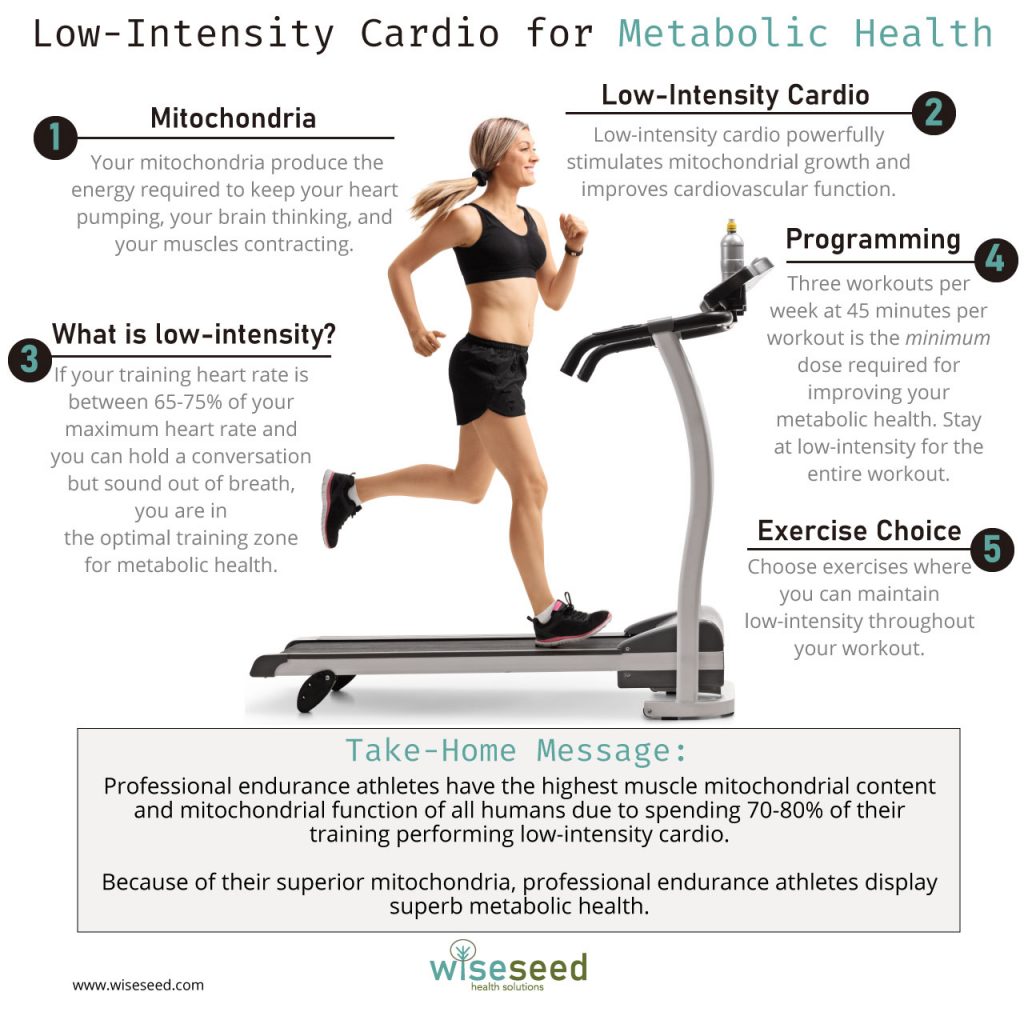Low-Intensity Cardio for Metabolic Health

‘Slow and steady wins the race.’
Aesop
Performing epic training routines that involve near superhuman efforts may make for excellent YouTube viewing. However, you don’t need to destroy yourself to get healthy.
Indeed, emerging research shows that low-intensity cardio is the best way to improve your metabolic and cardiovascular health.
What is metabolic health?
Metabolically health encompasses several core components.
First, the metabolically healthy burn fat as their primary energy source during low-intensity cardio (1). Second, metabolically healthy individuals have an increased capacity to clear lactate from their blood during exercise (1). Finally, metabolically healthy people control their blood sugar levels by rapidly responding to insulin (1).
In contrast, metabolically unhealthy individuals can’t efficiently utilize fat as an energy source and rely on carbohydrates for energy (1). Furthermore, the metabolically unhealthy are insulin resistant, meaning they have poor control over their blood sugar levels (1).
Being unable to burn fat or control blood sugar has severe long-term health consequences, including long-term disability and premature death. Avoid.
Mitochondria, the foundation of Metabolic Health
Mitochondria are structures present within your cells that function as the ‘powerhouse of the cell.’ Mitochondria consume oxygen, carbohydrates, and fats to produce the energy (in the form of ATP) required for your cells to function. It is your mitochondria that produce the energy necessary to keep your heart pumping, your brain thinking, and your muscles contracting.
Fortunately, a deep understanding of biochemistry isn’t required to improve your metabolic health (whew!).
However, it is crucial to understand that mitochondrial dysfunction contributes to poor health (1). For example, people with type 2 diabetes and obesity have damaged mitochondria, whereas healthy, lean individuals do not (1).
Aerobic Exercise and Mitochondrial Health
Fortunately, aerobic exercise improves your mitochondrial number and function (2). A striking example of exercise positively enhancing mitochondrial function is found in elite endurance athletes. Professional endurance athletes have the highest muscle mitochondrial content and mitochondrial function of all humans due to their extensive aerobic training regimes (1).
Because of their superior mitochondria, professional endurance athletes display superb metabolic flexibility. For example, elite endurance cyclists’ maximal fat usage occurs at around 250 watts of cycling output (1). Furthermore, elite athletes transition from fat to carbohydrate usage at about 300 watts of effort (1).
Compare this to a moderately active healthy adult, whose maximal fat-burning occurs at a mere 60 watts and who transitions from fat to carbohydrate usage at a measly 160 watts (1). Worse, people with metabolic syndrome can’t use fat as an energy source at even the mildest levels of physical exertion (1)!
Thus, your exercise regime profoundly impacts your metabolic health.
Low-Intensity Cardio is the Key to Metabolic Health
You might believe that professional endurance cyclists spend most of their time doing brutal hill climbs or long rides at close to maximum speed. However, professional endurance athletes perform roughly 80% of their training at low intensity (3)!
Why? Because it is low-intensity endurance training that most efficiently stimulates mitochondrial growth and improves cardiovascular function.
Importantly, low-intensity endurance training is not just for professional athletes, as it has a multitude of benefits for everyday people (1). These include:
- Low-intensity aerobic training is accessible to everyone as it isn’t physically demanding, just the opposite.
- Low-intensity endurance training burns the most fat of any exercise, making it an ideal approach for improving body composition.
- Low-intensity training improves your ability to burn fat by increasing your mitochondrial numbers.
- Low-intensity endurance training improves your cardiovascular health.
- Low-intensity endurance training increases your capacity to clear lactate, which improves your athletic performance.
- Low-intensity endurance training is easy on your body and has a low injury risk.
- Because low-intensity training uses fat as the primary fuel, it spares your muscle glycogen stores. Low-intensity aerobic exercise thus leaves your muscle glycogen stores available for other forms of high-intensity training, such as lifting weights.
- Low-intensity endurance training improves your overall work capacity, allowing you to train harder at the gym and perform better on the field.
- Low-intensity endurance training aids recovery by pumping blood to your muscles without overly taxing your body.
What is Low-Intensity?
Dr. Iñigo San-Millán has divided training intensity into six zones based on the primary muscle fiber and energy source used. Zone 2 is the optimal low-intensity training zone for improving metabolic and cardiovascular health.
There are two readily accessible ways to gauge whether you are in Zone 2, your heart rate and the talk test.
Heart Rate
In Zone 2, your heart should be between 65-75% of your maximum heart rate.
Calculating your Zone 2 HR: Simple Method
First, use the simple (220 – age) formula to estimate your maximum heart rate. Then, multiply your estimated maximum heart rate by 0.65 to determine your lower 65% heart rate and 0.75 to calculate your upper 75% value.
Calculating your Zone 2 HR: Reserve HR Method
Using your heart rate reserve to estimate your Zone 2 working range is more accurate than the simple method described above. Use the steps below to calculate your Zone 2 heart rate thresholds based on your reserve heart rate.
- Resting HR: Measure your resting heart rate using a fitness tracker before getting out of bed in the morning (or count your heartbeats for one minute).
- max HR = 220 – your age
- reserve HR = max HR – resting HR
- 65% hr = (0.65 x reserve HR) + reserve HR
- 75% hr = (0.75 x reserve HR) + reserve HR
The Talk Test
The talk test is a simple and convenient approach to gauge when you are in Zone 2: if you can hold a conversation but sound out of breath, you are in Zone 2.
Despite the simplicity of the talk test, it is the method of choice recommended by Dr. San-Millán.
Programming Zone 2 Training
According to expert opinion, you should perform at least three Zone 2 sessions per week to improve your metabolic health and cardiovascular fitness. Moreover, each Zone 2 workout must last at least 45 minutes.
Fortunately, performing two (45-minute) Zone 2 workouts per week is enough to maintain your current metabolic and cardiovascular health.
An important caveat for successful Zone 2 training is to stay within Zone 2 for the entire workout. If you exceed Zone 2, you risk activating biochemical pathways that block fat-burning metabolic adaptations.
Finally, you can (and should) include high-intensity work within your training program. However, to avoid sabotaging your Zone 2 gains, perform your high-intensity work after completing your Zone 2 training to avoid switching off your fat-burning systems. Alternatively, you can perform your Zone 2 and high-intensity workouts on separate days.
Exercise Selection
Last but not least, which exercises are best for Zone 2 training?

My suggestion is to choose whichever type of cardio you enjoy most and have at it!
However, consider choosing exercises where you can easily control your training intensity throughout your workout. For example, jogging on a treadmill, using a Concept 2 rower, or an indoor cycling trainer are great options for your Zone 2 workouts.
I combine my Zone 2 training while walking my dogs, so rucking with a weight vest is my go-to option for Zone 2. However, if you plan on performing your Zone 2 training outside, choose an appropriate route that permits you to maintain your Zone 2 pace for the entire workout.
Take-Home Message
Professional endurance athletes spend 80% of their time training at low intensity. Why? Because low-intensity cardio is optimal for increasing metabolic health and improving cardiovascular fitness.
Low-intensity endurance training is also a safe and pleasant way to exercise. So why not emulate the pros and make low-intensity cardio your go-to method to burn fat and improve your metabolic health?

References and Further Reading
1. I. San-Millán, G. A. Brooks, Assessment of Metabolic Flexibility by Means of Measuring Blood Lactate, Fat, and Carbohydrate Oxidation Responses to Exercise in Professional Endurance Athletes and Less-Fit Individuals. Sports Med 48, 467-479 (2018).
2. J. H. Hwang et al., TAZ links exercise to mitochondrial biogenesis via mitochondrial transcription factor A. Nat Commun 13, 653 (2022).
3. Y. Campos et al., Training-intensity Distribution on Middle- and Long-distance Runners: A Systematic Review. Int J Sports Med 43, 305-316 (2022).
Acknowledgements
Images created by nd3000 and Ljupco
Disclaimer
The material displayed on this website is provided without any guarantees, conditions or warranties as to its accuracy.
Information written and expressed on this website is for education purposes and interest only. It is not intended to replace advice from your medical or healthcare professional.
You are encouraged to make your own health care choices based on your own research and in conjunction with your qualified practitioner.
The information provided on this website is not intended to provide a diagnosis, treatment or cure for any diseases. You should seek medical attention before undertaking any diet, exercise, other health program or other procedure described on this website. To the fullest extent permitted by law we hereby expressly exclude all warranties and other terms which might otherwise be implied by statute, common law or the law of equity and must not be liable for any damages whatsoever, including but without limitation to any direct, indirect, special, consequential, punitive or incidental damages, or damages for loss of use, profits, data or other intangibles, damage to goodwill or reputation, injury or death, or the cost of procurement of substitute goods and services, arising out of or related to the use, inability to use, performance or failures of this website or any linked sites and any materials or information posted on those sites, irrespective of whether such damages were foreseeable or arise in contract, tort, equity, restitution, by statute, at common law or otherwise.

Ten Minutes is All You Need
Research has shown that ten minutes of moderate-to-vigorous exercise performed each day is enough to significantly reduce your risk of early death.

Three Strategies to Mitigate Cognitive Decline
There exist highly effective compensation strategies that can help you mitigate, and in many cases overcome, your cognitive limitations.




